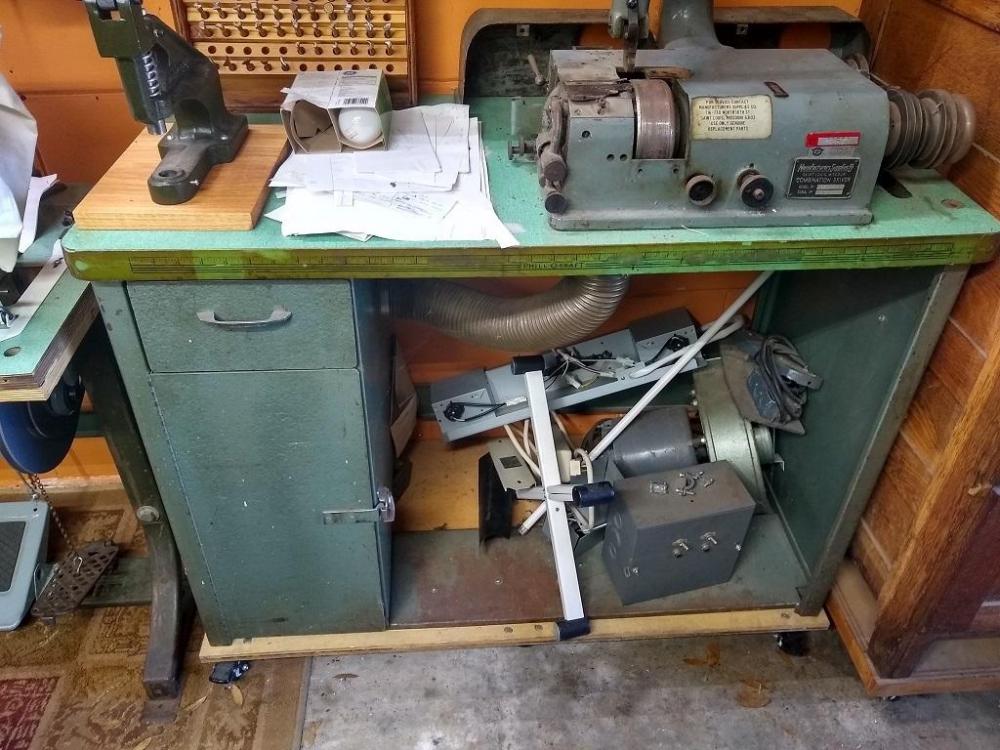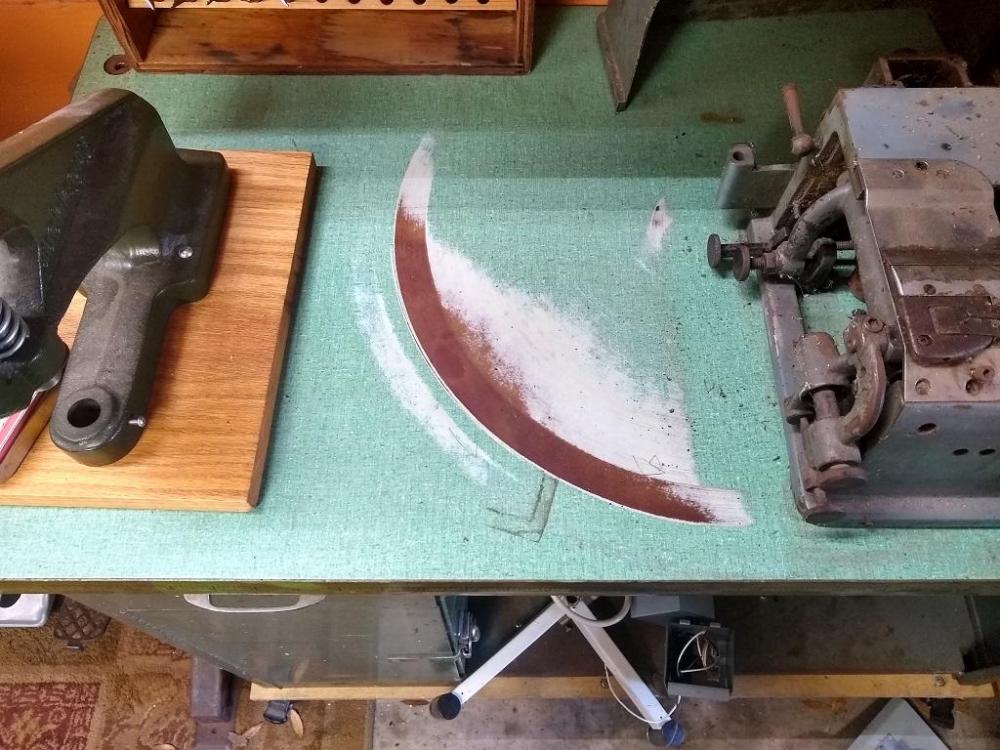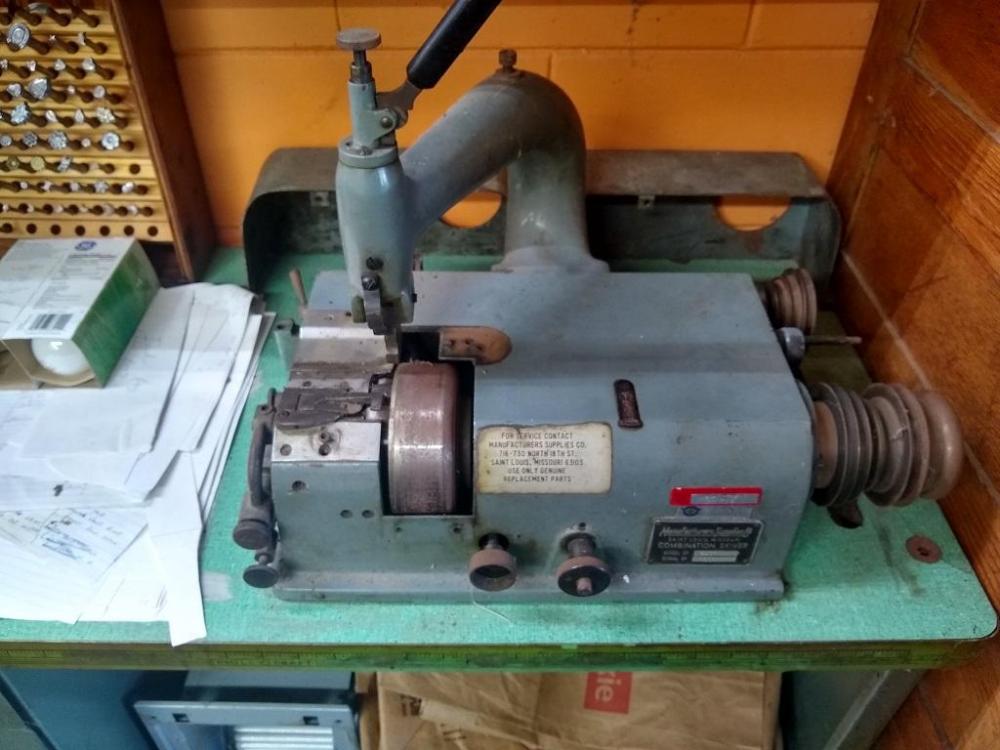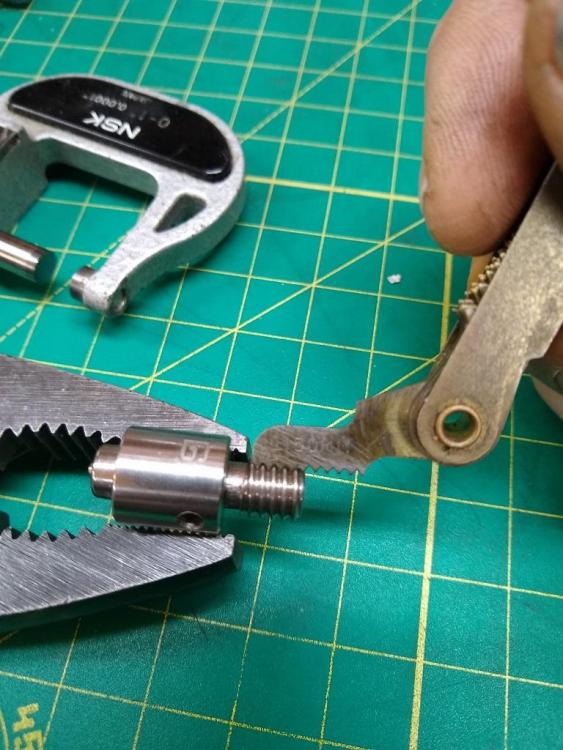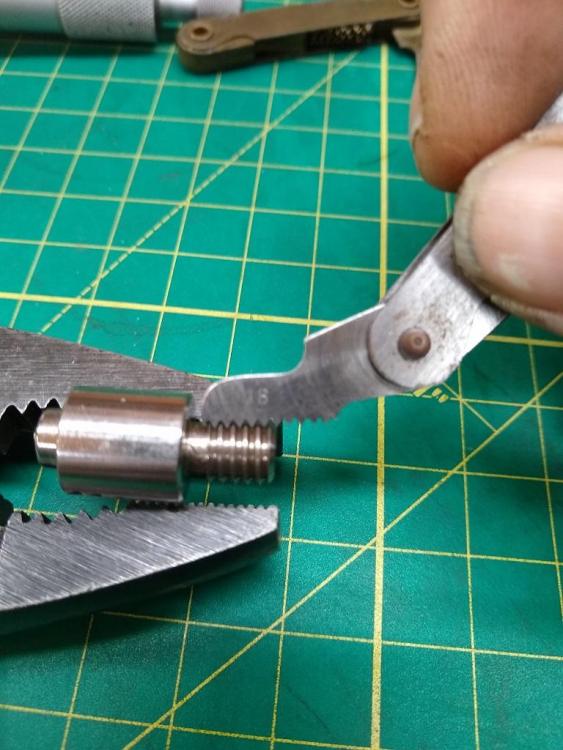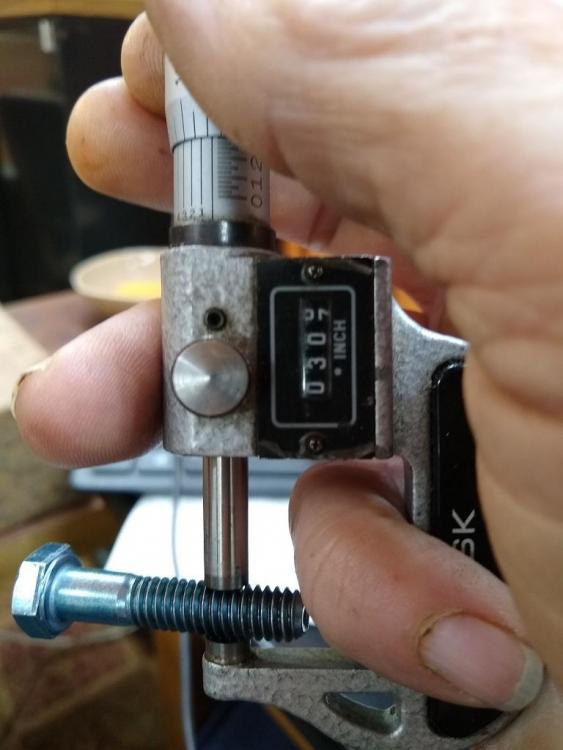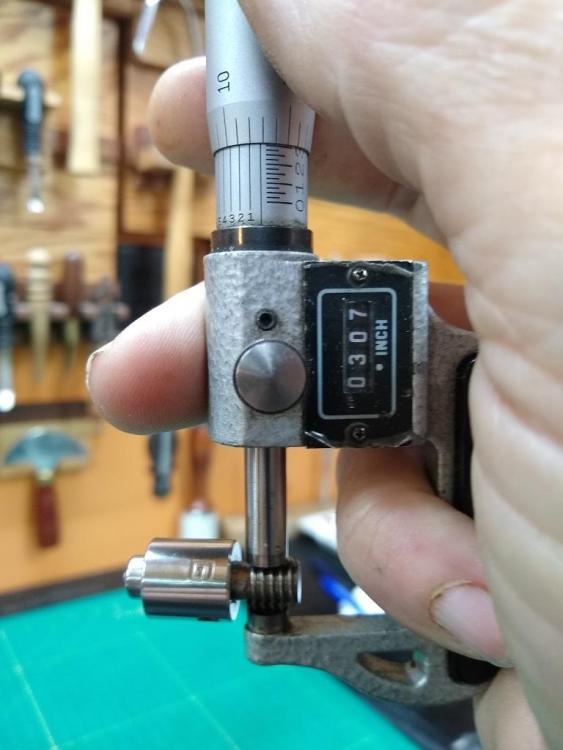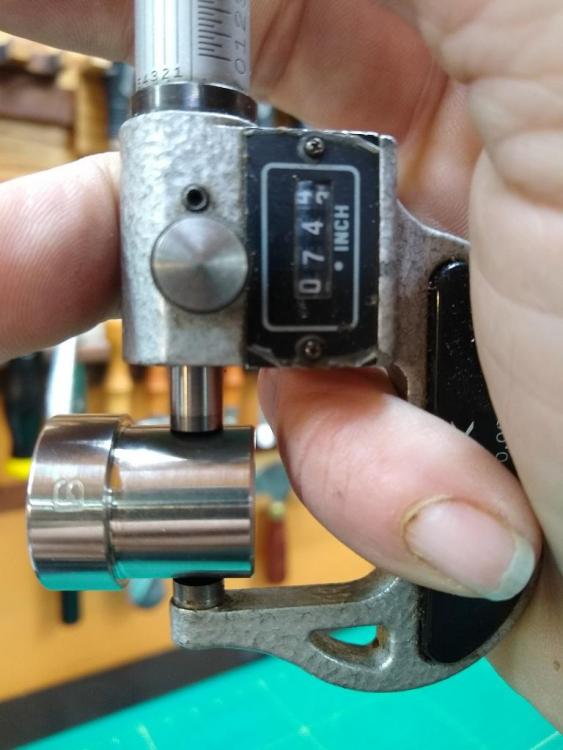
mcguyver42
Members-
Posts
58 -
Joined
-
Last visited
Content Type
Profiles
Forums
Events
Blogs
Gallery
Everything posted by mcguyver42
-
Hello, I would appreciate some advice on an old Bell Skiver I bought a while back. I am at the point of trying to decide whether this is a viable restoration project or a parts machine for someone else. It's a Manufacturer's Supply Company Model 15ASTN mounted on the original table with exhaust system and waste collection bin. Known Problems before tear-down: The left door is missing. I think there is a knob in that door that is a stop or adjustment for something, (knob missing too). I don't have the correct Spare parts manual, and don't really know much about these machines. Knife cover is missing The guide and feet are missing One of the pulleys has some pieces broken out If holding the knife still and rocking the pulley, there is almost 1/8" of lash Of course it will need a new knife, sharpening stone and belts Motors are 3 phase I want to experiment with some chrome tan projects. If this is beyond repair, a new or good used one will not be in my budget for some time. In that case, I might be looking for a manual alternative. Any recommendations? More
- 20 replies
-
- leather paring
- bell skiver
-
(and 1 more)
Tagged with:
-
Is this site legit??? Enduro servo motors
mcguyver42 replied to Brooksie's topic in Leatherwork Conversation
Sorry to just be coming back to this, I haven't been on the site for a bit. I did buy 2 of the 240 volt1400 watt motors after all. I haven't gotten around to trying out any of those motors yet, or even opening the box's. How are you guys using the 240 volt motors on 120 volt circuits? -
I've been looking with interest at the Japanese Oka stitching irons. There doesn't seem to be a lot of information available; Goods Japan is carrying some of their higher end edge tools. Leathertoolz has good things to say about their cutting/ punch board on his you tube channel. Has anyone bought or used the stitching irons
-
- oka
- stitching irons
-
(and 1 more)
Tagged with:
-
I think the point is value. Are you in a position and have the desire to deliver value? Value doesn't always mean the lowest price; as a matter of fact, value usually costs more, and there are plenty enough people who have learned that. If your expenses are such that you have to compromise, the value goes down, the percentage of repeat business and referrals follow. Here now, you can either scale things back or try to build an image to attract new business. If you don't have the desire to deliver value, well I guess that cant be learned or taught. You simply cash in by working the "spread". Hopefully most craftsman are the folks that have the desire to offer competent service or products at a fair price.
-
Well like fredk says, I have measuring equipment that would curl your hair, inside and outside micrometers that read to 1 10,000th. (.0001) snap guages and dial indicators, antique German Helios calipers and depth guages in velvet lined wood cases, on and on. That stuff rarely if ever gets used. A cheap 1" mike and 6" caliper with direct read scales is really all most of us need. Truth is, the human hand can easily discern ten thousandth's (.010) of an inch movement which is more than adequate for most everyday things until you start getting into high speed moving parts and then things tighten up a little but not much more.
-
Spyros, if I read your post correctly, you said that the Sedgewick English bridle leather doesn't accept any kind of a liquid finish very well on the flesh side, but that you are getting a durable glue bond when you line your items? When you go to finish your edges you are using Edge Kote because obviously any type of dye wouldn't match, (not to mention the unpredictable). Do you cut stitching grooves, or just let your stitches lay on top?
- 12 replies
-
- ruined leather
- leather care
- (and 3 more)
-
You just described my trusty old Red Wing boots on their 3rd pair of soles now!
- 12 replies
-
- ruined leather
- leather care
- (and 3 more)
-
Well that's interesting stuff, and that glue sure stands the test of time. I don't remember what we used in my good ol wood shop days in the 70's, but I think it must have been something from a bottle. So before the days when wood was painted with plastic, there were a few choices for a finish, and you occasionally hear someone refer to varnish. Is Pearl glue what they are referring to? I wonder if the pearl glue they are selling today is the real deal?
- 12 replies
-
- ruined leather
- leather care
- (and 3 more)
-
Thanks for the information on the lining. Using the bridle leather, I am making a badge holder with two pockets inside for my brother to wear on his belt. I lined the main shell of the case with pig skin last night. I may have got gotten a little heavy handed with the glue, as I seem to have a little bleed through on the pig skin, but I will see how well it holds.. If the bond fails, I think that I can fairly attribute it to the properties of the leather in general and not to my individual leather. I had to rejuvenate my can of Barge with quite a bit of xylene yesterday, so that may be a factor.
- 12 replies
-
- ruined leather
- leather care
- (and 3 more)
-
Well, the trouble that I was having was with the waste leather from the trash can. (From my shop in the garage). I thought the damaged leather would be ok for the tests that I was making. The salvaged leather which has been stored under heat and air for several days now with my other leather is beveling ok, and the salvage rate is really closer to 95+ percent. I have not tried burnishing yet. I was reading here that some people have had trouble burnishing Bridle leather, and I have seen the UK Saddlery video where he is using pearl glue and tallow to finish his edges. That guy knows his business, and I am going to try it. I was not familiar with pearl glue (hide glue). I have been meaning to research what kind of glue it was that they used for wood joinery back in the old days, so there is a bonus. I know that it is good practice to store leather inside and out of the light, but I would think leather tanned for such harsh conditions wouldn't react to the heat and humidity the way that mine did. Any ideas on that? I'm still not sure if oiling was a mistake on this type of leather, or what the temper of lighter weight English Bridle leather should be, but it appears that it may be usable for my practice purposes after all. Thanks again, and any input is appreciated.
- 12 replies
-
- ruined leather
- leather care
- (and 3 more)
-
Hello, I bought a big box of 2- ½-6 oz. Wickett and Craig English Bridle leather scrap to use for practice. By mistake, it got left out in my 90 plus degree, high humidity garage for almost a month. It was now stuck together, dye leaching out of the grain side in places and splotching on the flesh side, and the fibers unraveling on the edges. I cut away the bad parts and saved 90 plus percent of it. I gave every piece a light oiling of Neatsfoot oil rubbed in with a cloth and now wondering if that was a mistake. It seems like the temper is now maybe a little softer than it was? More like a chrome tan bag leather. I cant bevel the edge on the flesh side. It just pulls the fibers up from out of the gum paste. It doesn’t seem like it is going to edge burnish very well either. So are those the normal characteristics of lighter weight English Bridle leather or is it ruined? Thanks in advance
- 12 replies
-
- ruined leather
- leather care
- (and 3 more)
-
Well, glad that worked out for you, and I'll keep the helicoil tip in mind. Dynamo, I love it!
-
Ok, Whitworth, I've heard of that but not familiar. Was that a valve body?
-
Creeping Clarity, well said. Tapping a helicoil to a different thread, I never thought about that. Can they came back out if they need to and then go back in again?
-
Well that sounds like the best repair. Let us know how your heat imprinter project works out.
-
The other thing you could do is cut a groove into 2 sides of the threads of the thermocouple fitting, and let it cut it's own threads on the way in. I don't know how well it would ever come apart again, but it would go in and get tight
-
I was kind of thinking along the same line. I poked around a little bit and didn't really see much in the way of m6 x 1.25 helicoils though. Might be better off to just abandon the thermocouple and look for one without that oddball thread size.
-
But on with the headway. I measured the thread pitch of one of the upper dies with the brass metric thread pitch guage and found that it is 1.5 which may be common on machine threads, I don't know, but I've never heard of a 8 x 1.5 bolt. I measured it again with the silver steel SAE guage and found that 18 course is a perfect fit. I measured a 5/16 coarse bolt and found the diameter to be .307, remember that the 8mm measured .308. I tried a common 5/16" coarse nut and lo and behold, it screws on just like it was made for it. 5/16' coarse is nearly if not identical to 8 x 1.5.
-
Good to know about the free samples to try, I will keep that in mind. Nice to say about the contributing, I hope to pay it forward at some point. I did make a little headway with the hiker press. The stated sizes of the BG dies again are 7.8mm and 18.9mm. I measured them and they are spot on. .307" = 7.7978 mm., .744" =18.8976. After doing a little thinking and figuring, I realized that the difference between the 7.8mm and 8 mm is .2mm (just under .008"). The difference between 18.9mm and 19mm is .1mm obviously or just shy of .004". Those would be the necessary clearances for the respective bores, but those would generally just be called 8 and 19mm dies. .008 seems a bit much, but maybe that is the needed clearance for a bolt? I never really thought too much about it. If you were to cut threads on a bolt, the die is marked 8mm and we would call it a 8mm bolt, but it is actually cutting 7.8mm threads. I measured a standard 8mm bolt and lo and behold, there is our .308" or 7.8mm again. I guess otherwise it would be too confusing. We would have to call a 3/8" bolt a two hundred and ninety five thousandth's bolt. Sorry to go on about it, I just found it interesting, and it's been right there all along.
-
Well, I have heard both ways as far as being able to use different fasteners, snaps, and grommets with different brands of presses and dies, and different dies with different presses. Actually, I think that that is how I came across this particular thread. I was searching to see if anyone had any experience using Tandy hardware with Buckleguy dies. I thought that I remembered reading something about that here on Leatherworker.net, but I couldn't find it. That would be great news to find out that you are right, and that things are more generic along those lines than might be otherwise stated or implied. I called Buckleguy yesterday and asked Nicole if she thought I might be able to use up some of my Tandy hardware with Buckleguy dies. She didn't have any direct knowledge about that, and told me that of course she couldn't guarantee it, but that it would probably work. By the way, I'm not a Buckleguy commercial, but that's another great thing to like about them. When you call, you get an actual knowledgeable helpful employee or even the owner on the phone just like in the old days, instead of a customer service rep trained to politely put you off without actually being of any help. Well, I guess I will find out. I bought the press, the line 20 die set and the catalog last month. This morning I ordered both line 24 die sets, the 3 component pieces to do tubular rivets, (both splash and capped), 3 double cap die sets, and several bags of various fasteners and snaps. I'm all in for close to $750. now and I'm sure there will be another big order later to finish, but I've never been disappointed with anything that I have bought from them. I'll try to come back to this later and let you know if I have any success using the Tandy hardware and adapting my Hiker 901 to use the BG dies.
-
Everything about Buckleguy is top notch so I don't mean to speak badly of them, and the press and dies are excellent quality. The press is a little stiff at $200, but the dies are a bargain at less than $40. for a set.
-
Yeah, I will have to look into that again, now that I have some actual BG dies to try. It would be very convenient to have 2 presses, to minimize changing dies. Actually he was very clever, his die dimensions are 7.8 and 18.9mm, but leathercrafters are pretty clever too.
-
I bought a used Hiker press locally with the idea of doing something similar, but had to give in and buy his press because of the oddball sizes that he used for his dies. What size and thread pitch did you use?
-
Is this site legit??? Enduro servo motors
mcguyver42 replied to Brooksie's topic in Leatherwork Conversation
Enduro servo motors are all over ebay right now with heat/ water damaged box’s at well, fire sale prices, but the motors seem to be ok. The deals appear to be genuine, I bought some so I will let you know when they get here, but I think they are going fast. I would say jump in if you don’t mind 240 volts, as it appears that all of the 120v motors are sold. A decent quality 1000 watt step up transformer can be had for under $100 on Amazon if 240 volts is not available. I agree that I found better deals through questionable websites but I chose to buy through through an intermediary like ebay. I bought 5 SM645B-2p’s from an ebay seller for $199.75 ($39.95 each), with free shipping and free returns. I think I paid about that much each for the ones that I already have. Another note, these motors are 800 watts and full torque at even the slowest speed you cant hold the pully. I have been very happy with them. I couldn’t find any info on the differences between the 645 and the 645B, but the B may stand for brushless. My 2 older SM645-1p motors are brushless however. The 2 designates 240 volts, and the P is for positioner. Some models have an F for automatic foot lift. If you want even more power the SM1050-2p’s rated at 1400 watts are available for around $50. I didn’t go for those because the seller didn’t seem as trustworthy and no free returns. On a sad note, the Enduro Saves website appears to be down. -
Pfaff 1245-706/47 6/01 CLPMN hook saddle retrofit
mcguyver42 replied to mcguyver42's topic in Leather Sewing Machines
I will get working on that, thanks!


